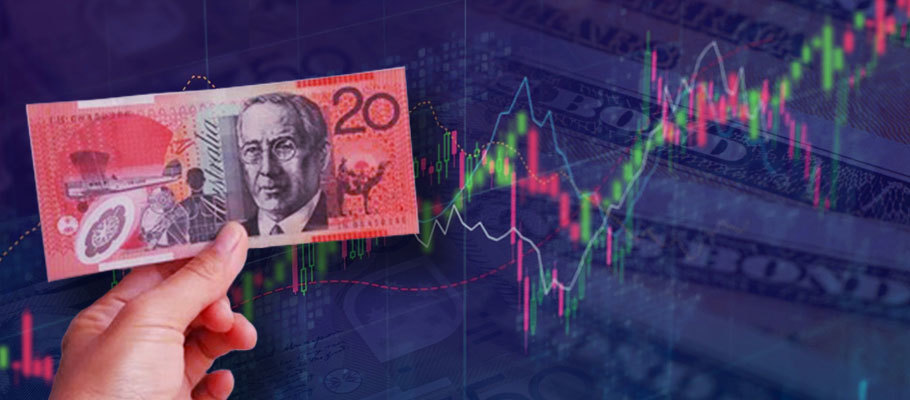
Published: January 19th, 2022
The Aussie (AUD) began the week of 17th January as one of the worst-performing majors, as ten-year yields on US bonds jumped to the highest levels seen since February of 2020. The rise in demand for government debt sent most of the world's biggest stock markets into losses.
Given AUD's 'high beta' status and its historically close connection to ebbs and flows in broader risk sentiment, it’s perhaps no surprise that the Australian dollar was on the up when markets were trending higher. It began to fall again when this week’s equities sell-off got underway.
The Australian dollar to US dollar exchange rate fell by a full third of a percentage point to trade at 0.7185, while the pound to Australian dollar exchange rate lifted by one-quarter of one per cent to reach 1.8969
Analysts at Markets.com posted a morning blog reflecting what many analysts said: 'markets headed lower as bond yields began to rise. The thing to watch for this week and into next will be whether or not US stock traders decide that the equities sell-off should continue or ease off.'
If American government bond yields continue to rise higher, it will have the knock-on effect of raising the cost of financing dollar-denominated around the globe. That could impact US demand for imports and dull the current global economic recovery.
Australia's top foreign exchange earner is its range of commodities used in manufacturing like iron ore. If global growth slows down, demand for Aussie experts will too. As long as bond yields continue their upward trajectory, AUD will likely stay under pressure.
One of the factors pushing bond yields higher is the market expectation for a combination of interest rate hikes and QE tapering by the US Fed this year and next. America is currently experiencing inflation levels not seen since the early 80s. That's putting pressure on Fed policymakers to raise interest rates and tighten up the easy money that's been available to markets during the pandemic.
‘Look for a cascade of lurches and retracements as markets price-in the dynamics of inflation and directional signals for Fed policy,’ said Markets.com.
As forex traders watch for the end of 'easy money over the coming months, the industries that benefited most from Fed stimulus will likely be hit hardest by scaled-back in quantitative easing.
One sector already feeling the impact of changing sentiment is technology, along with the burgeoning cryptocurrency market. Aussie bulls can expect further pressure on their AUD positions thanks to lowered expectations for Chinese economic growth.
Westpac's FX Strategy Unit said in an analyst note that the surge in domestic cases of the Omicron COVID-19 variant means China's economic data remains at significant risk, especially with its zero-tolerance policy when outbreaks are detected.
'As geopolitical factors such as the Ukraine situation and rising cyber-attacks, we think the Australian dollar is at risk of dipping further through the week’.
Despite this week’s turbulence, forex analysts at Dutch-based Rabobank are maintaining sunnier expectations for AUD over the coming months. In a research briefing published the week of 17th January, they said Australia’s labour market is robust, and rising wages will likely outstrip the forecasts to date from the Reserve Bank of Australia. Both indicators will create upside for the Aussie.
Rabobank’s call comes after a challenging year for the Down Under fiat, which saw it descend from a high of 0.79 against the greenback to a December low of 0.6994. The pound to Australian dollar rate rose steadily through the year, starting at 1.7414 in January to a peak of 1.9149 in November.
According to Rabobank, one of the significant influencers behind the AUD/USD's relative softness last year was the RBA's ongoing dovish policy stance. 'Going into this year, there is an opportunity for this to improve.'
They note that RBA Governor Philip Lowe has devoted a lot of time promoting the message that Australia’s interest rate outlook is inexorably linked to the country’s wage growth.
Australian wage growth has been low in recent years, and Rabobank says markets have linked wage growth and its impact on current RBA monetary policy.
The central bank's November statement said that economists were looking for wage growth to accelerate gradually at a rate of just above two per cent this year, rising to three per cent in 2023.
Wages are still close to their pre-COVID levels, but Rabobank expects upside surprises will pop up in this year's wage data.
If this is the outlook markets are starting to price in January, we'd expect AUD to find support if better-than-expected wage data arrives.'.
Momentum for stronger wage figures appears to be building. Australia’s official statistics agency ABS reported on 11th January that Australian job vacancies rose by more than 18 per cent in the three months to December 2021, lifting vacancies 74.1 per cent higher than they were in March 2020.
Australia now appears to be feeling the squeeze from a labour shortage, with the ABS noting that the ongoing rise in job vacancies reflects a robust recovery from lows seen in April 2020. 'Several key sectors are signalling labour shortages, particularly for lower-wage roles'.
Britain and the US have seen wages rise sharply and quickly, stoking concerns about higher inflation rates as 2022 progresses.
Both countries’ central bankers have already warned that higher interest rates will be needed to curb rampant price rises, a policy stance that pushed both sterling and the greenback to outperform G10 rivals in 2021.
Rabobank thinks the Aussie could benefit from a similar dynamic in 2022.
‘Looking to the first half of this year, we're starting from the assumption that more evidence of labour market strength is coming. When it does, it will raise expectations for a positive shift in RBA rhetoric and set the tone for an AUD uplift.